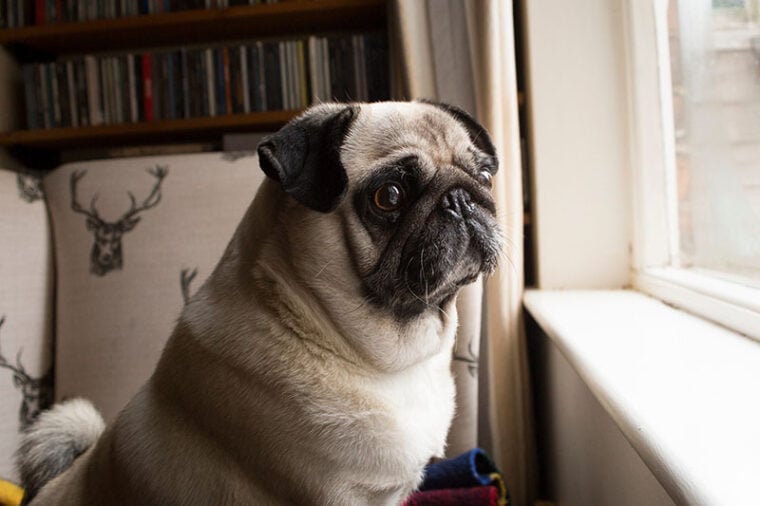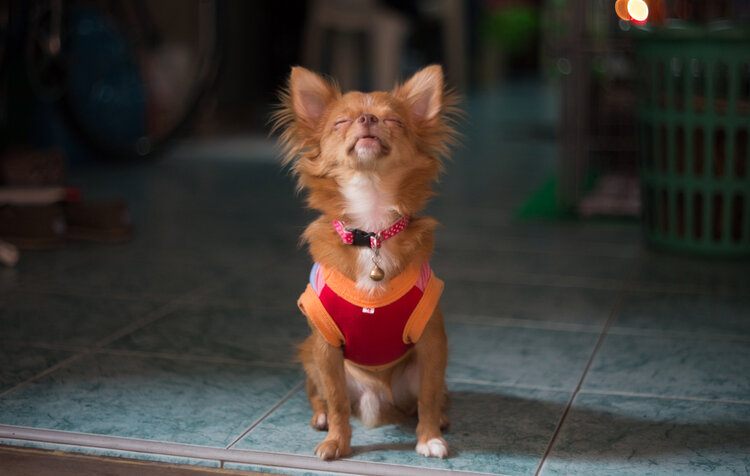
Separation anxiety is an extremely common problem for dogs. In fact, between 20 and 40 percent of dogs suffer from some level of separation anxiety. But before you can start treating separation anxiety you need to learn to recognize the signs.
With that in mind, we’ve highlighted 10 different signs that can point to separation anxiety with your dog for you here.
The 10 Signs of Separation Anxiety in Dogs
1. Excessive Vocalization
This is one of the most common signs of separation anxiety in dogs and one that can potentially get you into great problems with your neighbors.
If you live in a smaller apartment complex it can rise to the level of crisis in no time, while if you live way out in the country, it won’t affect anyone too much.
Either way, it’s a sign of separation anxiety that you’ll want to address, but if you don’t have any close neighbors, you’ll have a little more leeway as you figure things out.

2. Pacing
This is another super common sign of separation anxiety, and until recently, many pet owners didn’t even realize their pets displayed this behavior. However, as in-home cameras have become more common more and more pet owners have witnessed this behavior with their pets.
So, if your pup doesn’t do this while you’re around, there’s a good chance separation anxiety is the reason. It’s just like how you can’t sit still when something is really gnawing at you!
3. Excessive Drooling
This isn’t the most likely sign of separation anxiety, but if it’s one your pup displays, you’ll definitely want to take notice. Often, your only sign this is happening will be wet spots where they were laying, but even then, you’ll need to rule it out from typical drooling behavior.
What qualifies as excessive really depends on your dog, but if it’s more drooling than normal for them, it’s likely a sign of separation anxiety.
4. Refusal to Eat or Drink
If you go away for a trip, it’s common for a pet sitter to note that your pup isn’t eating or drinking as much as they should for the first day or two. If your dog is doing this with the pet sitter, there’s a good chance they’re doing it while you’re away for the day too.
Stress can create all sorts of dietary concerns for your pet. When you come back, they should eat and drink like normal again, and if you leave for a longer period, your dog will usually start eating and drinking like normal after a day or two.

5. Urination or Defecation
If you come home with urine or feces on the floor and they usually don’t do this while you’re home, the problem could be due to separation anxiety. We know it can be tempting to punish your dog for this, but this won’t give you the desired results.
You’ll need to address the underlying cause if you want the behavior to stop. If you try punishing them, this can only make them more nervous when you leave, which can just make the problem worse!
Inappropriate urination and defecation can also be the result of an underlying health issue, so please make sure you get your pup checked by the vet. Also consider that if you were away for too long or during hours your dog normally needs to go out, then this is just natural.
6. Chewing, Digging, & Other Destructive Behavior
When your dog destroys your home while you’re out, it’s easy to think that they’re doing it to try and “punish” you for leaving. This isn’t the case.
Many dogs simply can’t control some of their behaviors when they’re suffering from separation anxiety. They might damage door frames and window sills trying to get out, or they might be trying to dig out through the carpet.
Dogs don’t realize how your home works, and they’re trying to do everything they can to get to you. You don’t want to punish this behavior; otherwise, it’ll just create more anxiety the next time you leave.
7. Escaping
If your dog suffers from separation anxiety, all they can think about when you’re not home is trying to get back to you. In these situations, all they want to do is be near you, and they will do everything they can to escape to find you.
You might want to cage your dog to help with this behavior, but often they’ll self-harm as they try to escape. Because of this, you’ll want to do everything you can to treat the separation anxiety instead of just controlling the sign.

8. Panting
Panting is your dog’s way of cooling themselves down, and when their heart rate increases from separation anxiety, it can quickly cause them to overheat a little.
For a healthy dog, this mild separation anxiety shouldn’t create major concerns, but you should still address the issue to try and get your dog a bit more comfortable when you leave the home.
9. Anxiety at Departure Cues
Dogs are intelligent creatures, and it won’t take them long to realize when you’re getting ready to step out of the house. Perhaps it’s when you’re getting your shoes on, or maybe it’s when you grab the car keys.
No matter what the cue is, if your dog starts to display abnormal behavior when you’re getting ready to leave the house, they’re likely suffering from separation anxiety. Typically, if they display obvious anxiety cues when you’re getting ready to leave, they’ll also display additional signs after you leave too.
10. Excessive Excitement Upon Reunification
Let’s be honest here for a second; whose puppy doesn’t get super excited when they see you again? It’s perfectly normal for a dog to get super excited when they see you, but sometimes, it can be a sign of a deeper problem.
If this is the only sign your dog is exhibiting, we wouldn’t worry about it, but if your dog is showing other signs, it might be separation anxiety.

Final Thoughts
Separation anxiety is extremely common in dogs, and before you can treat anything, you need to recognize when your dog is struggling.
If your dog is exhibiting separation anxiety signs, we highly recommend reaching out to a professional who can help walk you through everything you can do to help your pet with the problem while protecting your home and keeping your dog happier whenever you need to leave home!
Featured Image Credit: Diana Parkhouse, Shutterstock






